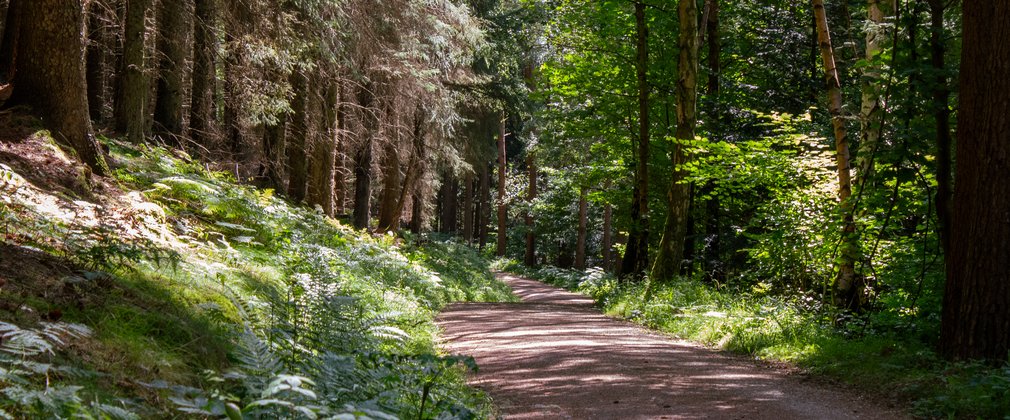Dalby Forest Plan
A forest plan is a description of the woods or forest as it is now and what is considered when deciding what is best for the future. The forest plan describes how the forest will develop over time and gives specific information about approved tree felling, replanting and regeneration over the next ten years.
About Dalby Forest
Dalby Forest is an area of 3575.8 hectares of primarily coniferous forest with some broadleaves situated in the east of the North York Moors National Park which is collectively known as the North Riding Forest Park.
The land at Dalby has a long history of human activity and intervention. Centuries of change saw the pre-historic primary woodland starting to be cleared by Neolithic and early Bronze Age ancestors, but more radical change occurred around the Iron Age with the introduction of farming.
The land was acquired by the FC in the early 1920’s and shortly afterwards started establishing the forest on land that had previously been managed as rough pasture. With the exception of 19.6 ha of leasehold land at Ellers Wood and 7.8 ha at South Moor Farm, Dalby is a freehold property.
Sitka spruce is the dominant species accounting for 30% of the planted area, with larch and pine at 16% each. Mixed broadleaves comprised mainly of beech account for 11%, but also birch, ash, sycamore, alder and oak as lesser components. Open space including agricultural land, felled and unplanted land currently accounts for 17% of the forest area.
Dalby forest lies at the hub of recreational activity within the Yorkshire Forest District. Receiving more than 450 000 day visits per annum, it is a popular tourist location at all times of the year offering a range of opportunities including: walking, mountain biking, orienteering, horse riding/trekking, picnic sites, children’s play areas and a scenic forest drive. Except for leasehold areas, Dalby forest is dedicated as access woodland under CRoW legislation, thereby allowing unrestricted pedestrian access across the majority of the property.
Within Dalby there are four designated Sites of Special Scientific Interest and although Dalby is a predominantly secondary plantation conifer forest, around 120 ha are classed as Ancient Woodland Sites of which 14 ha are ancient semi-natural woodland (ASNW) and the remainder are plantation ancient woodland sites (PAWS).
Dalby forest also contains a rich and regionally important resource of historic features with 83 scheduled monuments, several of which are of significant importance at a landscape scale, and over 600 unscheduled monuments.
Objectives of the plan
The overall plan and long term vision for Dalby Forest is to increase the proportion of native broadleaf cover, particularly across areas of PAWS and areas of high conservation value.
Environmental objectives
- Conserve veteran trees and continue the restoration of PAWS to native woodland and associated plant communities.
- Maintain the woodlands contribution to the wooded character within the NYMNPA Forest (Dalby Forest) character through the maintenance and development of structural and species diversity.
Economic objectives
- In line with climate change projections, maintain a sustainable supply of timber from a more diverse range of site appropriate conifer and broadleaf species.
- Provide recreational opportunities and facilities within the forest in a way, and at a rate, that maintains their economic and social function, whilst achieving the plans’ other objectives.
- Maintain the woodlands contribution to the wooded character within the NYMNPA Forest (Dalby Forest) character through the maintenance and development of structural and species diversity.
Social objectives
- Provide recreational opportunities and facilities within the forest in a way, and at a rate, that maintains their economic and social function, whilst achieving the plans’ other objectives.
- Ensure scheduled and unscheduled ecological and historic features are maintained in target condition and improved where opportunities arise, to be measured by English Heritage, Natural England, Non-Government Organisations and FC systems accordingly.
What we'll do
The Dalby Forest Plan outlines management proposals including felling, thinning and restocking for 9 years until 2021.
Planned areas for conifer, broadleaf and open space at the end of the plan are outlined in the following table:
| Habitat type (based on principal species established) |
Area – hectares |
% age of total area |
| Conifer | 2404 | 67 |
| Broadleaf | 821 | 23 |
Open space (i.e. heathland/ agriculture/recreation) |
350 |
10 |
We will ensure that all sites, regardless of their designation, will receive the same level of care during the planning and execution of forest operations. The operational planning system will ensure they are recognised and the proper measures for their protection are in place before work begins. This planning system also ensures that, where possible, opportunities to enhance the condition of archaeological and historic interest are taken during routine forest work.
We will increase the diversity of tree species and age structure that will maintain and improve favourable habitats for target species and identified habitats. This is particularly beneficial for the range of habitats and species recorded at Dalby.
Priority will be given to control and progressively remove invasive species (e.g. rhododendron, Himalayan balsam and Western hemlock) across Ancient Woodland Sites and other sites identified as being of High Conservation Value.
We will continue to sustainably harvest timber both from clearfell and thinnings, and where appropriate develop broadleaf stands to increase their contribution to timber production. These operations will be planned and controlled to ensure due regard for all other objectives of management at Dalby.
This table illustrates how the plan will progress:
| Felling | Area - hectares |
% of total area | Projected volume (m3) |
| 2013 – 2016 Clearfell | 103 | 2.9 | 51000 |
| 2017 – 2021 Clearfell | 109 | 3.0 | 97500 |
| 2022 – 2023 Clearfell | 46 | 1.3 | 44600 |
| Continuous Cover | 60 | 1.7 | 21000 |
| Minimum Intervention | 98 | 2.7 |

